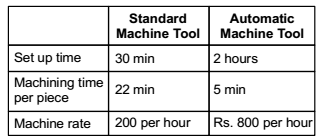Industrial Engineering Miscellaneous
- A standard machine tool and an automatic machine tool are being compared for the production of a component.

For line balancing the number of work stations required for the activities M, E and T would respectively be
-
View Hint View Answer Discuss in Forum
Given data

Total cost of z1 component by using standard machine tool,(TC)1 = 
30 + 22 × z1 
× 200 = 100 + 2200 z1 60 60 30
Total cost of z2 component by using Automatic Machine tool,(TC)2 = 
2 + 5 × z2 
× 800 = 1600 + 2000 z2 60 30
Let break even point be z number of components∴ 100 + 2200 z = 1600 + 2000z 30 30 or 200 z = 1500 30 or z = 1500 × 30 = 225 200 
Alternately:
Let N be the Break even number
At Break even point
1 + 22 .N 
= 
2 + 5N 
× 800 2 60 60 200 ⇒ 1 + 22 N = 
2 + 5N 
× 800 2 60 60 200 ⇒ 1 + 22 N = 8 + 20N 2 60 60 ⇒ 22 N − 20 N = − 1 60 60 2 ⇒ 
22 − 20 
N = 16 − 1 60 2 ⇒ N = 15 × 60 = 225 2 × 2 Correct Option: D
Given data

Total cost of z1 component by using standard machine tool,(TC)1 = 
30 + 22 × z1 
× 200 = 100 + 2200 z1 60 60 30
Total cost of z2 component by using Automatic Machine tool,(TC)2 = 
2 + 5 × z2 
× 800 = 1600 + 2000 z2 60 30
Let break even point be z number of components∴ 100 + 2200 z = 1600 + 2000z 30 30 or 200 z = 1500 30 or z = 1500 × 30 = 225 200 
Alternately:
Let N be the Break even number
At Break even point
1 + 22 .N 
= 
2 + 5N 
× 800 2 60 60 200 ⇒ 1 + 22 N = 
2 + 5N 
× 800 2 60 60 200 ⇒ 1 + 22 N = 8 + 20N 2 60 60 ⇒ 22 N − 20 N = − 1 60 60 2 ⇒ 
22 − 20 
N = 16 − 1 60 2 ⇒ N = 15 × 60 = 225 2 × 2
- Two machines of the same production rate are available for use. On machine 1, the fixed cost is Rs. 100 and the variable cost is Rs. 2 per piece produced. The corresponding numbers for the machine are Rs. 200 and Rs. 1 respectively. For certain strategic reasons both the machines are to be used concurrently. The sale price of the first 800 units is Rs. 3.50 per unit & and subsequently it is only Rs. 3.00. The breakeven production rate for each machine is
-
View Hint View Answer Discuss in Forum
For Machine M1:
Fixed cost = Rs 100
Variable cost = Rs 2 per piece
For Machine M2:
Fixed cost = Rs 200
Variable cost = 1 Rs per piece
Total cost = Fixed cost + Variable cost × Number of units.
Total cost of production on machine M1 & M2 is
⇒ 100 + 2n + 200 + n = 300 + 2n
For the first 300 units, selling price is 3.50 Rs per unit.
So the break even point
300 + 3n = 3.50 (n+n)
300 + 3n = 3.50 (2 n)
7n = 300 + 3n = n = 75Correct Option: A
For Machine M1:
Fixed cost = Rs 100
Variable cost = Rs 2 per piece
For Machine M2:
Fixed cost = Rs 200
Variable cost = 1 Rs per piece
Total cost = Fixed cost + Variable cost × Number of units.
Total cost of production on machine M1 & M2 is
⇒ 100 + 2n + 200 + n = 300 + 2n
For the first 300 units, selling price is 3.50 Rs per unit.
So the break even point
300 + 3n = 3.50 (n+n)
300 + 3n = 3.50 (2 n)
7n = 300 + 3n = n = 75
- Demand during lead time with associated probabilities is shown below:

Expected demand during lead time is
-
View Hint View Answer Discuss in Forum
Probability

Expected demand during lead time
⇒ 7.5 + 9.8 + 15.75 + 16 + 25.5 = 74.55Correct Option: C
Probability

Expected demand during lead time
⇒ 7.5 + 9.8 + 15.75 + 16 + 25.5 = 74.55
- The jobs arrive at a facility, for service, in a random manner. The probability distribution of number of arrivals of jobs in a fixed time interval is
-
View Hint View Answer Discuss in Forum

Since arrival rates depends upon the time factor, so accordingly graph can be chosen from Poisson distribution, but normal distribution expresses same result throughout.Correct Option: B

Since arrival rates depends upon the time factor, so accordingly graph can be chosen from Poisson distribution, but normal distribution expresses same result throughout.
- The symbol used for Transport in work study is
-
View Hint View Answer Discuss in Forum
NA
Correct Option: A
NA

